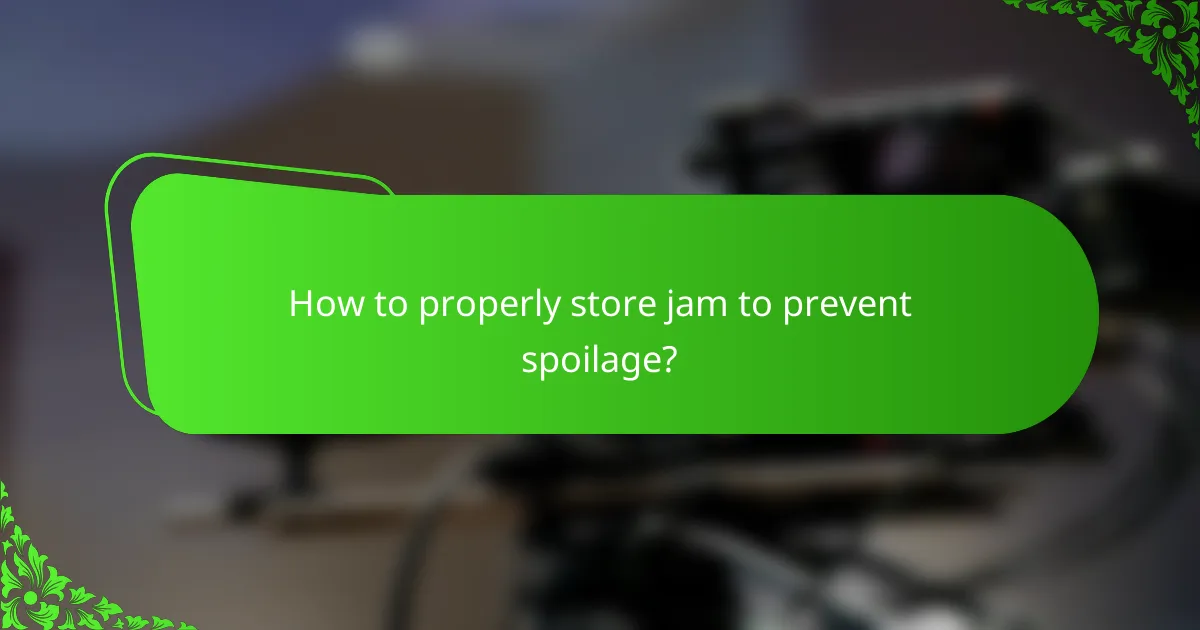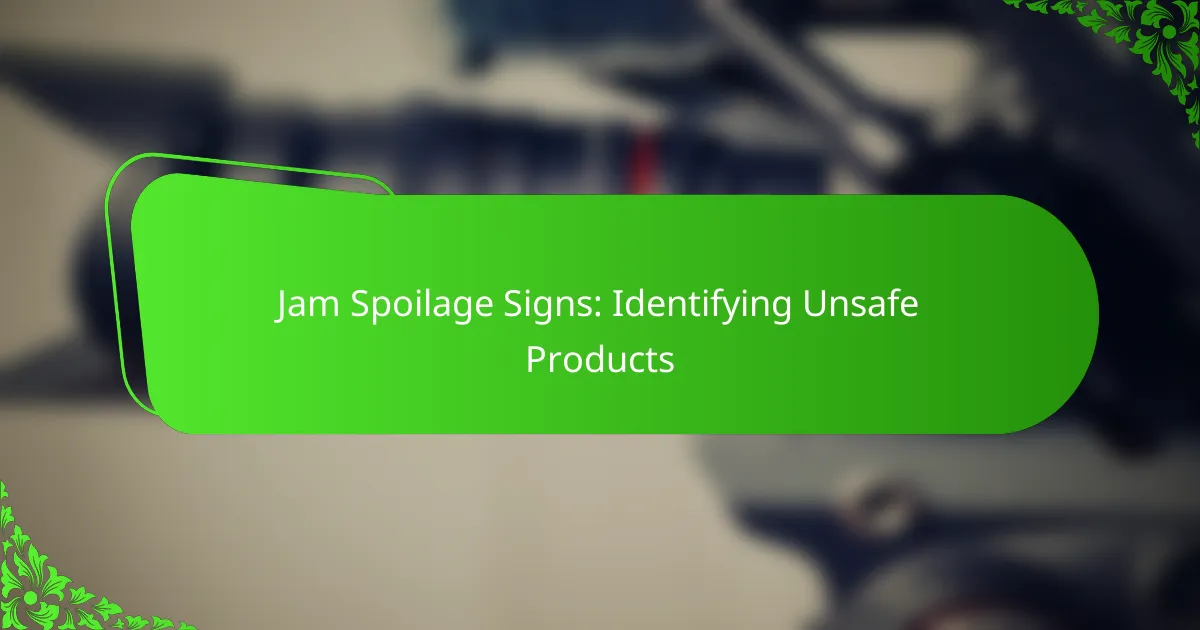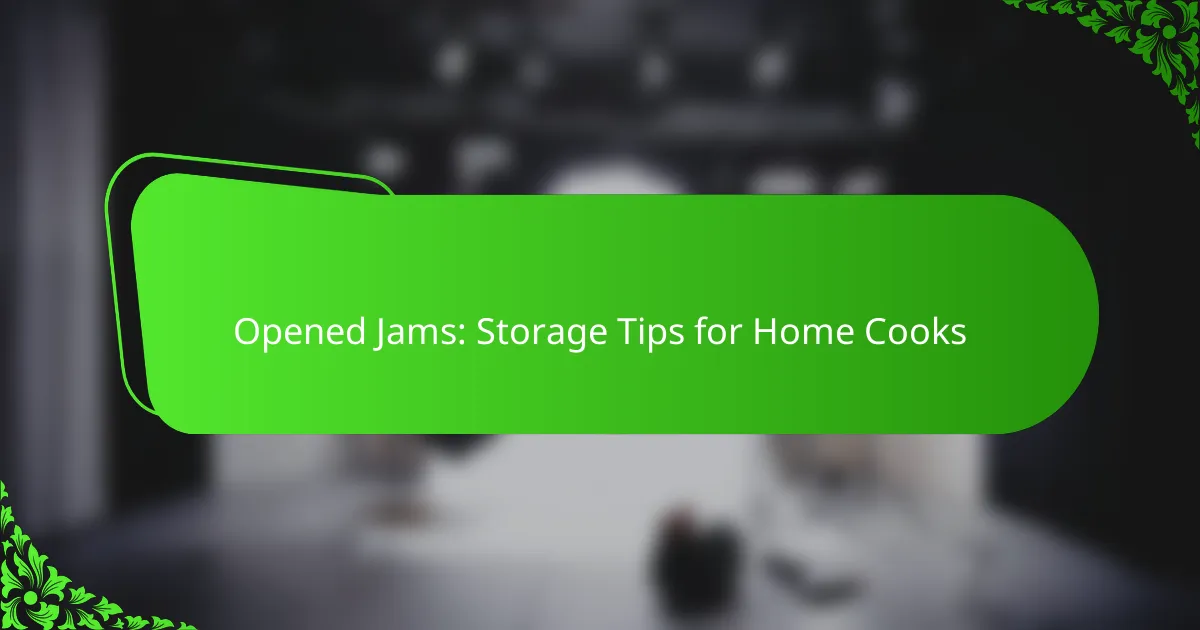Identifying signs of jam spoilage is essential for ensuring food safety and preventing health risks. Key indicators include visible mold, unusual odors, color changes, liquid separation, and texture alterations. By recognizing these signs, you can avoid consuming unsafe products and protect your well-being.

What are the signs of jam spoilage?
Signs of jam spoilage include visible mold, unusual odors, color changes, liquid separation, and texture alterations. Recognizing these indicators is crucial to ensure food safety and prevent consumption of spoiled products.
Mold growth on the surface
Mold growth is one of the most apparent signs of jam spoilage. If you see any fuzzy or discolored spots on the surface, it’s best to discard the jam entirely, as mold can produce harmful toxins that penetrate beyond the visible area.
Even if the mold appears only on the surface, it can indicate that the jam has been compromised. Always check the entire jar, as mold can sometimes develop in less visible areas.
Unusual odor
An unusual odor is a clear warning sign that jam may be spoiled. Fresh jam typically has a sweet, fruity scent, while spoiled jam may emit sour, fermented, or off-putting smells.
If the aroma is significantly different from what you expect, it’s safer to err on the side of caution and discard the product. Trust your senses; if it smells bad, it’s likely unsafe to eat.
Change in color
A change in color can indicate spoilage in jam. If the jam darkens or develops an unusual hue, it may be a sign that it has gone bad.
While some color variations can occur naturally over time, significant changes, especially when combined with other spoilage signs, warrant caution. Always inspect the jam closely before consumption.
Separation of liquid
Separation of liquid in jam can be a sign that it has spoiled. If you notice a layer of liquid forming on top or around the edges, this could indicate fermentation or bacterial growth.
While some separation can occur in homemade jams due to natural ingredients, excessive liquid separation is a red flag. If it looks unusual, it’s best to discard the jam.
Unusual texture
An unusual texture can signal that jam is no longer safe to eat. If the jam feels excessively gritty, watery, or slimy, these changes often indicate spoilage.
Texture changes can result from bacterial activity or improper storage. Always check the consistency of the jam before using it, and if it feels off, it’s safer to throw it away.

How to properly store jam to prevent spoilage?
To prevent spoilage, store jam in conditions that inhibit bacterial growth and maintain its flavor. Proper storage techniques include keeping it in a cool, dark place, using airtight containers, and refrigerating it after opening.
Keep in a cool, dark place
Storing jam in a cool, dark place helps to slow down the degradation of its ingredients. Ideal storage temperatures are typically between 10°C and 20°C (50°F to 68°F). Avoid areas exposed to sunlight or heat sources, as these can accelerate spoilage.
Consider using a pantry or cupboard that remains consistently cool. Regularly check the temperature to ensure it stays within the recommended range, as fluctuations can affect the jam’s quality over time.
Use airtight containers
Airtight containers are essential for preserving the freshness of jam by preventing exposure to air and moisture. Glass jars with tight-fitting lids or plastic containers designed for food storage work well. Ensure that the containers are clean and dry before filling them with jam.
When sealing the container, make sure there are no gaps that could allow air in. This will help to minimize oxidation and the risk of mold growth, extending the shelf life of your jam significantly.
Refrigerate after opening
Once opened, jam should be refrigerated to inhibit bacterial growth and maintain its flavor. Most jams can last for several weeks to a few months in the fridge, depending on their ingredients and sugar content. Always check the label for specific storage instructions.
When storing opened jam, ensure the lid is securely tightened after each use. If you notice any signs of spoilage, such as off smells or mold, discard the jam immediately to avoid health risks.

What are the risks of consuming spoiled jam?
Consuming spoiled jam can lead to various health risks, including foodborne illnesses, allergic reactions, and digestive issues. Recognizing the signs of spoilage is crucial to avoid these potential dangers.
Foodborne illness
Foodborne illnesses can occur when spoiled jam contains harmful bacteria, molds, or toxins. Symptoms may include nausea, vomiting, diarrhea, and abdominal cramps, which can arise within hours to days after consumption.
To minimize the risk, always check for signs of spoilage such as off smells, unusual colors, or mold growth. If any of these indicators are present, it is best to discard the jam immediately.
Allergic reactions
Some individuals may experience allergic reactions to certain ingredients in jam, especially if the product has spoiled or contains contaminants. Symptoms can range from mild hives to severe anaphylactic reactions.
If you have known allergies, always read labels carefully and avoid consuming jam that appears compromised. When in doubt, err on the side of caution and dispose of any questionable products.
Digestive issues
Digestive issues can arise from consuming spoiled jam due to the presence of harmful bacteria or excessive sugar content that can upset the stomach. Common symptoms include bloating, gas, and diarrhea.
To prevent digestive discomfort, store jam properly in a cool, dry place and ensure that it is sealed tightly. Always inspect the product before use, and if it has been opened for an extended period, consider discarding it to avoid potential digestive problems.

What should you do if you suspect jam spoilage?
If you suspect jam spoilage, act quickly to ensure safety. Discard the jam immediately, check for any recalls, and contact the manufacturer for further guidance.
Discard the product immediately
When you notice signs of spoilage in jam, such as off smells, unusual colors, or mold, it is crucial to discard the product without hesitation. Consuming spoiled jam can lead to foodborne illnesses, which can be serious.
Seal the jar tightly before disposing of it to prevent contamination. It’s advisable to check the expiration date and any storage instructions to understand how spoilage may have occurred.
Check for recalls
After discarding the jam, check for any recalls related to the product. Manufacturers may issue recalls due to safety concerns, including contamination or labeling errors.
You can visit the official website of the manufacturer or check government food safety sites for the latest recall information. This step ensures you are aware of any broader safety issues affecting the product you purchased.
Contact the manufacturer
Reaching out to the manufacturer can provide valuable insights into the jam’s safety. They can confirm if there have been any reported issues with the batch you purchased and offer guidance on what to do next.
When contacting them, have your product details ready, including the brand, flavor, and any codes on the jar. This information will help them assist you more effectively.

What are the best practices for jam preservation?
To ensure jam preservation, it is essential to follow specific techniques that prevent spoilage and maintain quality. Proper canning methods and monitoring pH levels are crucial steps in achieving safe and delicious homemade jams.
Use proper canning techniques
Using correct canning techniques is vital for jam preservation. This includes sterilizing jars and lids, using a water bath or pressure canner, and ensuring a proper seal. Always fill jars to the recommended headspace to allow for expansion during processing.
Common pitfalls include not processing jars long enough or using jars that are not designed for canning. Always check for any signs of spoilage before consuming, such as bulging lids or off smells.
Monitor pH levels
Monitoring the pH levels of your jam is crucial for safety and quality. The ideal pH for fruit jams is typically between 2.8 and 3.5, which helps inhibit the growth of harmful bacteria. You can use pH strips or a digital pH meter for accurate readings.
When making jam, consider adding lemon juice or citric acid to lower the pH if necessary. Regularly checking pH levels can help ensure your jam remains safe to eat and maintains its flavor profile.










